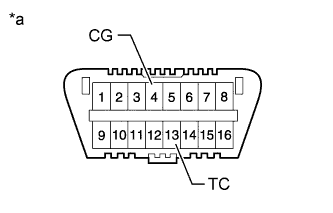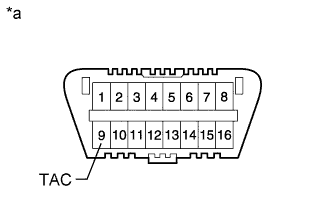Engine -- On-Vehicle Inspection |
| 1. INSPECT ENGINE COOLANT |
| 2. INSPECT ENGINE OIL |
| 3. INSPECT BATTERY |
| 4. INSPECT FAN AND GENERATOR V BELT |
| 5. INSPECT V-RIBBED BELT TENSIONER ASSEMBLY |
| 6. CHECK AIR CLEANER FILTER ELEMENT SUB-ASSEMBLY |
Remove the air cleaner filter element.
Visually check that the air cleaner filter element is not excessively damaged or oily.
If necessary, replace the air cleaner filter element.
| 7. INSPECT IGNITION TIMING |
- NOTICE:
- Turn all electrical systems off.
Warm up the engine.
When using the intelligent tester:
Connect the intelligent tester to the DLC3.
Enter the following menus: Powertrain / Engine and ECT / Data List / All Data / IGN Advance.
Inspect the ignition timing during idling.
- Standard ignition timing:
- 7 to 24° BTDC @ idle (transmission in neutral and A/C switch off)
Check that the ignition timing advances immediately when the engine speed is increased.
When not using the intelligent tester:
Using SST, connect terminals 13 (TC) and 4 (CG) of the DLC3.
- SST
- 09843-18040
Text in Illustration *a Front view of DLC3 - NOTICE:
- Be sure not to improperly connect the terminals. This may damage the engine.
Connect the tester probe of a timing light to the wire of the ignition coil connector for the No. 1 cylinder.
- NOTICE:
- Use a timing light that detects primary signals.
- After the inspection, be sure to wrap the wire harness with tape.
Inspect the ignition timing during idling.
- Standard ignition timing:
- 8 to 12° BTDC @ idle (transmission in neutral and A/C switch off)
Remove SST from the DLC3.
Inspect the ignition timing during idling.
- Standard ignition timing:
- 7 to 24° BTDC @ idle (transmission in neutral and A/C switch off)
Disconnect the timing light from the engine.

| 8. INSPECT ENGINE IDLE SPEED |
- NOTICE:
- Turn all the electrical systems off.
Warm up the engine.
When using the intelligent tester:
Connect the intelligent tester to the DLC3.
Enter the following menus: Powertrain / Engine and ECT / Data List / All Data / Engine Speed.
Inspect the engine idle speed.
- Standard idle speed:
- 650 to 750 rpm (transmission in neutral and A/C switch off)
When not using the intelligent tester:
Connect SST to terminal 9 (TAC) of the DLC3.
- SST
- 09843-18030
Text in Illustration *a Front view of DLC3 Race the engine at 2500 rpm for approximately 90 seconds
Inspect the engine idle speed.
- Standard idle speed:
- 650 to 750 rpm (transmission in neutral and A/C switch off)
 |
| 9. INSPECT COMPRESSION |
Warm up and stop the engine.
Remove the intake air surge tank (HILUX_TGN26 RM000002I4V00CX.html).
Remove the 6 spark plugs (HILUX_TGN26 RM0000015PS00BX.html).
Disconnect the 6 injector connectors.
Inspect the cylinder compression pressure.
Insert a compression gauge into the spark plug hole. (Procedure A)
While cranking the engine, measure the compression pressure. (Procedure B)
- Compression pressure:
- 1300 kPa (13.3 kgf/cm2, 189 psi) or higher
- Minimum pressure:
- 1000 kPa (10.2 kgf/cm2, 145 psi)
- Difference between each cylinder:
- 100 kPa (1.0 kgf/cm2, 15 psi) or less
- HINT:
- Use a fully-charged battery so that the engine speed can be increased to 250 rpm or more.
- Measure the compression in as short a time as possible.
Repeat procedures A and B for each cylinder.
If the cylinder compression is low, pour a small amount of engine oil into the cylinder through the spark plug hole and repeat procedures A and B for cylinders with low compression.
- If adding oil increases the compression, the piston rings and/or cylinder bore may be worn or damaged.
- If pressure stays low, a valve may be stuck or seated improperly, or there may be leakage from the gasket.
- If adding oil increases the compression, the piston rings and/or cylinder bore may be worn or damaged.
Connect the 6 injector connectors.
Install the 6 spark plugs (HILUX_TGN26 RM0000015PQ00EX.html).
Install the intake air surge tank (HILUX_TGN26 RM000002I4S00CX.html).
| 10. INSPECT CO/HC |
- HINT:
- This check is to determine whether or not the idle CO/HC concentration complies with regulations.
Start the engine.
Run the engine at 2500 rpm for approximately 180 seconds.
Insert the CO/HC meter testing probe at least 40 cm (1.31 ft) into the tailpipe during idling.
Immediately check the CO/HC concentration during idling and/or at 2500 rpm.
- HINT:
- When carrying out the 2 tests (idling and 2500 rpm), the measurement orders are prescribed by the applicable local regulations.
If the CO/HC concentration does not comply with regulations, perform troubleshooting in the order given below.
Check the air fuel ratio sensor operation (HILUX_TGN26 RM000002RV201RX.html) and heated oxygen sensor operation (HILUX_TGN26 RM000002RV601FX.html).
Refer to the table below for possible causes, and then inspect and correct the corresponding causes if necessary.
CO HC Problem Possible Cause Normal High Rough idle 1. Faulty ignitions: - Incorrect timing
- Fouled, shorted or improperly gapped plugs
3. Leaky intake and exhaust valves
4. Leaky cylindersLow High Rough idle
(Fluctuating HC reading)1. Vacuum leaks: - PCV hose
- Intake manifold
- Throttle body
High High Rough idle
(Black smoke from exhaust)1. Restricted air filter
2. Plugged PCV valve
3. Faulty SFI system:- Faulty pressure regulator
- Defective engine coolant temperature sensor
- Faulty ECM
- Faulty injector
- Faulty throttle position sensor
- Faulty mass air flow sensor
- Incorrect timing